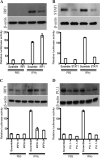Molecular mechanisms for synchronized transcription of three complement C1q subunit genes in dendritic cells and macrophages
- PMID: 21862594
- PMCID: PMC3186423
- DOI: 10.1074/jbc.M111.286427
Molecular mechanisms for synchronized transcription of three complement C1q subunit genes in dendritic cells and macrophages
Abstract
Hereditary homozygous C1q deficiency is rare, but it almost certainly causes systemic lupus erythematosus. On the other hand, C1q levels can decline in systemic lupus erythematosus patients without apparent C1q gene defects and the versatility in C1q production is a likely cause. As an 18-subunit protein, C1q is assembled in a 1:1:1 ratio from three different subunits. The three human C1q genes are closely bundled on chromosome 1 (C1qA-C1qC-C1qB) and their basal and IFNγ-stimulated expression, largely restricted to macrophages and dendritic cells, is apparently synchronized. We cloned the three gene promoters and observed that although the C1qB promoter exhibited basal and IFNγ-stimulated activities consistent with the endogenous C1qB gene, the activities of the cloned C1qA and C1qC promoters were suppressed by IFNγ. To certain extents, these were corrected when the C1qB promoter was cloned at the 3' end across the luciferase reporter gene. A 53-bp element is essential to the activities of the C1qB promoter and the transcription factors PU.1 and IRF8 bound to this region. By chromatin immunoprecipitation, the C1qB promoter was co-precipitated with PU.1 and IRF8. shRNA knockdown of PU.1 and IRF8 diminished C1qB promoter response to IFNγ. STAT1 instead regulated C1qB promoter through IRF8 induction. Collectively, our results reveal a novel transcriptional mechanism by which the expression of the three C1q genes is synchronized.
Figures










References
-
- Reid K. B. (1986) Essays Biochem. 22, 27–68 - PubMed
-
- Walport M. J. (2001) N. Engl. J. Med. 344, 1058–1066 - PubMed
-
- Fujita T., Matsushita M., Endo Y. (2004) Immunol. Rev. 198, 185–202 - PubMed
-
- Colten H. R., Strunk R. C., Perlmutter D. H., Cole F. S. (1986) Ciba Found. Symp. 118, 141–154 - PubMed
-
- Müller W., Hanauske-Abel H., Loos M. (1978) J. Immunol. 121, 1578–1584 - PubMed
Publication types
MeSH terms
Substances
LinkOut - more resources
Full Text Sources
Research Materials
Miscellaneous

